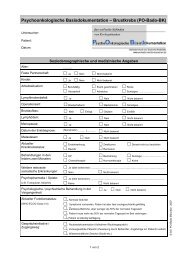PO-Bado Manual (2 - PO-Bado - TUM
PO-Bado Manual (2 - PO-Bado - TUM
PO-Bado Manual (2 - PO-Bado - TUM
Create successful ePaper yourself
Turn your PDF publications into a flip-book with our unique Google optimized e-Paper software.
<strong>PO</strong>-<strong>Bado</strong> <strong>Manual</strong> (© work group <strong>PO</strong>-<strong>Bado</strong> 2004) 6<br />
3. Instructions for the rating of each item<br />
3.1 Sociodemographic und medical data<br />
This section contains:<br />
• central socio-demographic data (age, sex, occupational situation etc.),<br />
• data on the cancer and treatment,<br />
• other clinical details<br />
• contact initiative / way of admission.<br />
Steady relationship refers to spouses or other long-term partners. Whether it is a heterosexual<br />
or homosexual relationship is not relevant, nor is whether the partners cohabitate. The<br />
decisive point is whether the relationship involves commitment and is stable. If, for example, a<br />
man lives separated from his wife and has no other relationship it would not be considered a<br />
steady relationship.<br />
In the line work situation, only one answer possibility should be marked. Employed includes<br />
full-time and part-time work as well as self-employment, but does not include minor or casual<br />
jobs. Home duties refers to patients without gainful employment, e.g. housewives or people<br />
who are otherwise not gainfully employed (but not to retired or unemployed people). Sick<br />
leave refers to people with an incapacity to work (or people with medically certified sick leave).<br />
Unemployed refers to patients receiving unemployment benefits or looking for work. Retired<br />
includes the age pension and disability pension. Other refers to situations not included in the<br />
presented options, e.g. study, apprenticeship.<br />
For the current tumour diagnosis, one of the twelve response categories is to be marked.<br />
The detailed definitions of the diagnostic categories and the corresponding ICD-10 codes are<br />
presented in a summary table in the appendix.<br />
In addition, it is recorded whether metastases were diagnosed.<br />
Date of first diagnosis refers to the date at which the patient first received a diagnosis of<br />
cancer. In the case of several tumour illnesses, the date of the first illness is to be recorded,<br />
even if this does not concord with the answer given under tumour diagnosis.<br />
Current illness status: First illness refers to patients for whom a cancer has been diagnosed<br />
for the first time. Recurrence / Progression refers to cases in which a cancer diagnosed and<br />
treated earlier returns as a local recurrence or as metastases. Second tumour means that a<br />
new tumour has been diagnosed which is independent of an earlier cancer. Remission is used<br />
in the case of successful cancer treatment and no current evidence of cancer (NED: no








